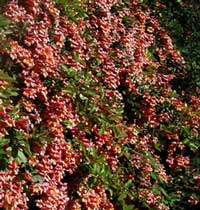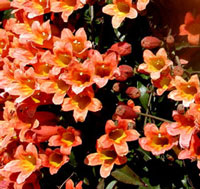Resource Library
Plant of the Week: Crossvine
The University of Arkansas System Division of Agriculture does not promote, support or recommend plants featured in "Plant of the Week." Please consult your local Extension office for plants suitable for your region.
Plant of the Week
Crossvine
Latin: Bignonia capreolata

The vining habit of growth is a useful one for plants because it gives them an opportunity to climb or crawl over anything in its way to get the sunlight they need. But these same characteristics give nurserymen and gardeners problems.
We like it best when plants behave like good little soldiers, all staying in their neat little rows. There are lots of opportunities to use vines in gardens, we only need to be a bit more creative.
One of the best, but least used native vines for our gardens is crossvine, Bignonia capreolata. It occurs in the wild statewide, except for the Ozark region; but it’s hardy statewide and will probably grow and flower as far north as St. Louis.
Crossvine is a fast growing, semi-evergreen vine that produces thumbsized, trumpet- shaped flowers in mid spring. It belongs to the trumpet-creeper family, and with catalpa and trumpet vine, shares the peculiar long, bean-like capsules that contain a number of wind-borne seeds. It’s called crossvine because the pith of larger stems resembles the shape of a Greek Orthodox cross when cut in half.
The outside of the typical crossvine flower is red to brownish-orange, the inside yellow.

But selections have been made from the wild, so all red forms (‘Atrosanguinea’ and ‘Dragon Lady’), an all yellow form (‘Tangerine Beauty’) and ‘Jekyll’, (orange) are available from specialist growers. In sunny sites the vines will be covered in flowers for about four weeks, usually from mid-April to mid-May. A few of the selections are said to repeat bloom during the summer.
Crossvine has a trifoliate leaf, but the terminal leaflet has been converted into a tendril to aid in climbing. The tendril has a foot at its end that allows it to cement itself to a tree trunk or wooden fence, so its twining stems do not need a trellis for climbing. The elongated leaflets are 4 or 5 inches long. The vine will also sprawl across the ground, but flowering is limited to upright stems.
While crossvine is fast growing, it doesn’t seem desirous of taking over the world. Plants on the U of A research farm planted by Dr. Jon Lindstrom seven years ago in a full-sun situation on a wire fence have spread down the fence about 6 feet on either side of the trunk. This would be an ideal plant to use to soften the backside of the wooden fences surrounding many of our back yards. It grows just as easily on chain-link fence.
Crossvine is best grown in sunny situations to achieve maximum flowering. It does best in fertile, well-drained soils. Once established, it has considerable drought tolerance. It has few insect or disease problems. Few nurseries stock the plant, but it’s easily found from mailorder sources on the Web.
By: Gerald Klingaman, retired
Extension Horticulturist - Ornamentals
Extension News - June 9, 2006
The University of Arkansas System Division of Agriculture does not maintain lists of retail outlets where these plants can be purchased. Please check your local nursery or other retail outlets to ask about the availability of these plants for your growing area.